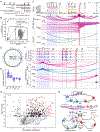In Situ Capture of Chromatin Interactions by Biotinylated dCas9
- PMID: 28841410
- PMCID: PMC6857456
- DOI: 10.1016/j.cell.2017.08.003
In Situ Capture of Chromatin Interactions by Biotinylated dCas9
Abstract
Cis-regulatory elements (CREs) are commonly recognized by correlative chromatin features, yet the molecular composition of the vast majority of CREs in chromatin remains unknown. Here, we describe a CRISPR affinity purification in situ of regulatory elements (CAPTURE) approach to unbiasedly identify locus-specific chromatin-regulating protein complexes and long-range DNA interactions. Using an in vivo biotinylated nuclease-deficient Cas9 protein and sequence-specific guide RNAs, we show high-resolution and selective isolation of chromatin interactions at a single-copy genomic locus. Purification of human telomeres using CAPTURE identifies known and new telomeric factors. In situ capture of individual constituents of the enhancer cluster controlling human β-globin genes establishes evidence for composition-based hierarchical organization. Furthermore, unbiased analysis of chromatin interactions at disease-associated cis-elements and developmentally regulated super-enhancers reveals spatial features that causally control gene transcription. Thus, comprehensive and unbiased analysis of locus-specific regulatory composition provides mechanistic insight into genome structure and function in development and disease.
Keywords: CRISPR/Cas9; DNA looping; biotinylation; chromatin; cis-regulatory elements; enhancers; proteomics; super-enhancers.
Copyright © 2017 Elsevier Inc. All rights reserved.
Figures







Comment in
-
Technique: CRISPR CAPTURE for multi-omic probing of genomic loci.Nat Rev Genet. 2017 Nov;18(11):641. doi: 10.1038/nrg.2017.79. Epub 2017 Oct 3. Nat Rev Genet. 2017. PMID: 28970588 No abstract available.
References
-
- Beard C, Hochedlinger K, Plath K, Wutz A, and Jaenisch R (2006). Efficient method to generate single-copy transgenic mice by site-specific integration in embryonic stem cells. Genesis (New York, NY : 2000) 44, 23–28. - PubMed
MeSH terms
Substances
Grants and funding
LinkOut - more resources
Full Text Sources
Other Literature Sources
Molecular Biology Databases
Research Materials

